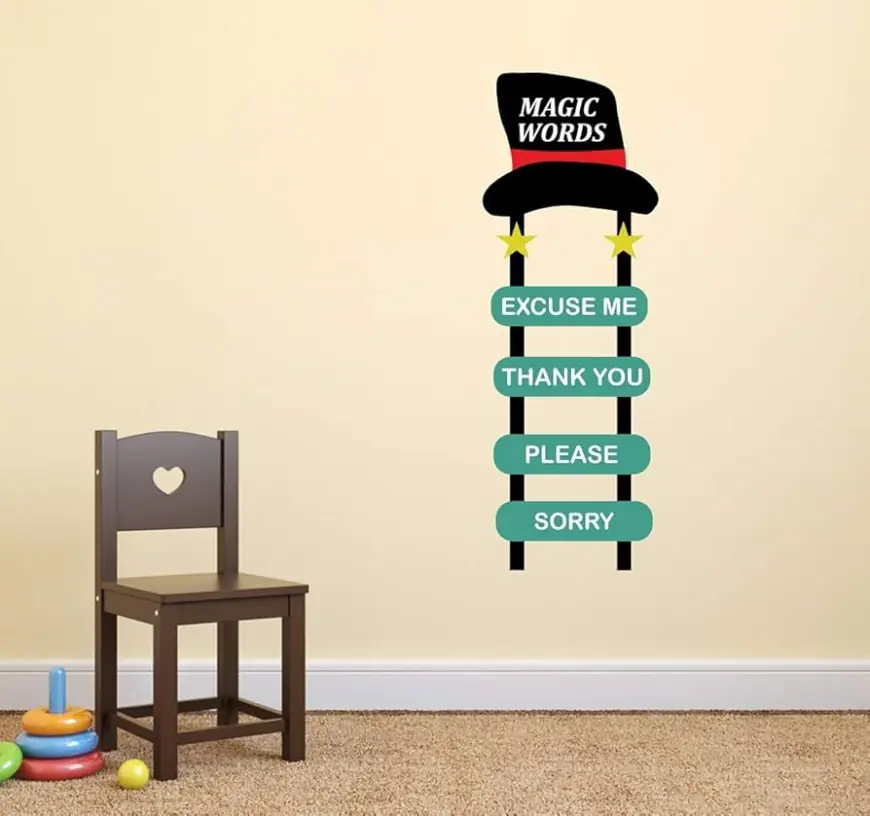Magic Words - Wall Chart in English: A Simple Way to Teach Good Manners
In this post, we’ll dive into everything you need to know about Magic Words - Wall Charts in English—why they work, how to use them effectively, and how they compare with other teaching methods.

Politeness and respect never go out of style. Yet, many parents, teachers, and caregivers struggle with one crucial question: how do you teach children to use polite language consistently? The answer often lies in creating a fun, visual, and easy-to-understand reminder. That’s where a Magic Words - Wall Chart in English becomes an invaluable tool.
This simple yet powerful resource helps children internalize phrases like please, thank you, sorry, excuse me, and you’re welcome. It not only improves their communication skills but also nurtures values like kindness, empathy, and respect. Whether displayed at home, in a classroom, or in a daycare, a magic words chart can transform daily interactions into opportunities for positive learning.
Why a Magic Words - Wall Chart in English is More Than Just Decoration
Many parents buy wall charts only to find them collecting dust after a few weeks. The real value of a magical words chart lies in its ability to act as both a visual cue and a behavioral guide.
Children are naturally visual learners. When polite words are displayed in bright colors and supported by relatable images, kids begin to connect good manners with everyday situations. For example, a magic words chart with pictures showing a child sharing toys with a friend reinforces not just the word please, but also the context of when and how to use it.
Key benefits include:
-
Reinforces positive communication daily.
-
Builds vocabulary and comprehension in English.
-
Provides consistency for teachers and parents.
-
Encourages self-reminders rather than constant correction.
-
Creates a positive environment at home or in the classroom.
The Essential “Magic Words” Every Child Should Know
A magic word chart usually focuses on a small but powerful set of words. These words act as social lubricants, making interactions smoother and more respectful.
Here are the most common ones:
-
Please – Encourages polite requests.
-
Thank you – Shows appreciation.
-
Sorry – Promotes empathy and accountability.
-
Excuse me – Teaches respect for others’ space.
-
You’re welcome – Completes the gratitude cycle.
-
May I – Helps children frame respectful questions.
When these words are introduced visually, supported by illustrations or real-life examples, children internalize them faster and use them more naturally.
How a Magic Words Chart with Pictures Boosts Learning
Text-only reminders often go unnoticed, especially by younger learners. That’s why a magic words chart with pictures is so effective. Pictures help children link the word with its context, making learning more memorable.
For example:
-
A picture of a child raising their hand before speaking can represent Excuse me.
-
A drawing of a child handing over a toy can show Please.
-
A smiling friend receiving a gift can illustrate Thank you.
By connecting words with emotions and situations, the magical words chart bridges the gap between abstract concepts and real-world behavior.
Comparing Magic Words Charts With Other Learning Tools
Parents and educators often wonder: Why use a wall chart when we already have storybooks or digital apps? Here’s a quick comparison to highlight the unique advantages of wall charts.
Magic Words - Wall Chart in English vs. Storybooks
-
Storybooks provide context through storytelling, but children may not recall specific polite phrases when needed.
-
Wall charts serve as constant visual reminders, ensuring the words stay front of mind.
Magic Words - Wall Chart in English vs. Digital Apps
-
Apps are engaging but require screen time and supervision.
-
Wall charts are always visible, require no devices, and promote independent learning.
Verdict: A wall chart is not meant to replace other methods but to complement them. Storybooks and apps add depth, while the chart provides daily reinforcement.
Best Practices for Using a Magic Words Chart
Simply hanging up a magic word chart isn’t enough. To make it effective, follow these strategies:
1. Place It at Eye Level
Children should be able to see the chart without straining. Eye-level placement ensures they notice and use it.
2. Refer to It Daily
Reinforce learning by pointing to the chart during real situations. For example, ask: What do we say when we get a gift? and guide the child to “Thank you.”
3. Pair It With Praise
When children use magic words, acknowledge their effort: I love how you said “please”! That was very polite.
4. Keep It Colorful and Fun
Bright colors, playful fonts, and friendly illustrations keep kids engaged and prevent the chart from blending into the background.
5. Refresh Regularly
Update the chart or rotate designs every few months to keep it exciting and prevent it from becoming invisible through overfamiliarity.
Real-Life Examples: Magic Words in Action
-
At Home: A parent uses a magic words chart with pictures on the fridge. Each time their child uses a polite word correctly, they place a sticker next to it. By the end of the week, the chart is full of stickers, reinforcing positive habits.
-
In Classrooms: Teachers often use a magical words chart during circle time. When students role-play scenarios like borrowing a pencil, the teacher points to the chart to remind them which magic words to use.
-
In Daycare: Caregivers place the chart near play areas, so children naturally see it when sharing toys or asking for turns.
These practical uses highlight why wall charts outperform abstract reminders.
Choosing the Right Magic Words - Wall Chart in English
Not all charts are created equal. When selecting one, consider the following factors:
-
Language clarity: Words should be simple, bold, and easy to read.
-
Visual appeal: Look for charts with bright, engaging illustrations.
-
Durability: Laminated or high-quality prints last longer, especially in classrooms.
-
Age appropriateness: Younger kids benefit more from picture-heavy designs, while older children may prefer text-focused charts.
Frequently Asked Questions
What are “magic words” in English?
Magic words refer to polite expressions like please, thank you, sorry, excuse me, and you’re welcome. They are called “magic” because they transform ordinary interactions into positive ones.
Why should I use a magic words chart at home?
A chart provides a constant visual reminder for children, helping them internalize polite language faster without needing constant verbal corrections.
Can a magic words chart with pictures help toddlers?
Yes. Toddlers are highly visual learners, so pairing words with pictures makes it easier for them to grasp both meaning and usage.
How do I keep children interested in the chart?
Use interactive methods like stickers, role-playing, or reward systems. Refreshing the design every few months also helps maintain interest.
Is a magical words chart suitable for older kids?
Absolutely. While older children may not need illustrations, charts with motivational quotes or situational examples can reinforce respectful communication.
Why Magic Words Still Matter in the Digital Age
In today’s fast-paced world, where children often spend more time with screens than face-to-face conversations, magic words are more critical than ever. Social skills cannot be replaced by technology, and teaching kids to say please and thank you lays the foundation for empathy, collaboration, and leadership in the future.
A Magic Words - Wall Chart in English is a timeless tool—simple, effective, and adaptable across generations.
Final Thoughts
Teaching manners shouldn’t feel like a daily battle. With the right tools, it can become natural, engaging, and even fun. A Magic Words - Wall Chart in English serves as a visual reminder, a teaching aid, and a behavior guide all in one.
Whether you’re a parent who wants a calmer household, a teacher shaping respectful students, or a caregiver nurturing social skills in little ones, a magic words chart can make all the difference.
By combining visual learning, positive reinforcement, and consistent practice, these charts help children master the language of respect—words that will serve them for a lifetime.
What's Your Reaction?
 Like
0
Like
0
 Dislike
0
Dislike
0
 Love
0
Love
0
 Funny
0
Funny
0
 Angry
0
Angry
0
 Sad
0
Sad
0
 Wow
0
Wow
0

















































